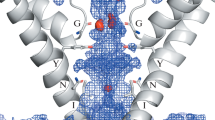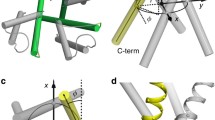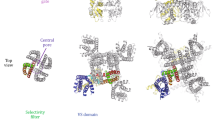Abstract
A functional model for the S4/IV α-helix of the action potential sodium channel is described by means of a thermodynamic approach. The model is based on a phase transition between the α-helix and an ion conducting channel-helix which is similar to the well established helix-coil transition in solution. The right hand channel-helix is a peptide chain with an alternating sequence of torsional angles (φ1ψ1)=(87°, 315°) and (φ2ψ2)=(22°, 107°) which yields a helix of 13.5 Å per turn. The axial dipole moments of the peptide bonds of this chain of l-amino acids nearly cancel each other out in similar way to those in the gramicidin A channel, which is formed by alternating d-and l-amino acids. The helix, which does not contain any H-bonds, is stabilized by a helical file of water molecules which includes the permeating ion(s). This file turns around the channel-helix to form a relatively stable “double helix” structure which corresponds to the open channel. Since every third side chain in the S4/IV helix carries a positive charge their environments must be polarized. These polarized regions form a left hand screening-helix around the α-helix are broken and the internal α-carbon atom is considered as fixed, the outer ten residues leave the membrane while the internal ten residues form the channel-helix. In this configuration every positively charged side chain matches nearly exactly every second polarized region of the screening-helix leaving the three regions in-between exposed to the water file containing the ion(s). This further stabilizes the channel and agrees nicely with the idea of cationic selectivity. An analysis of the energetics of the α-helix-channel-helix transition showed that the voltage-independent part of the free energy per helix residue could well be close to 0 kcal/mol and thus be in the range where a transition could occur. Two voltage-dependent contributions were included: the break down of the considerable dipole of the α-helix and the outward shift of the positive charges of the side chains upon channel-helix formation. Taking into account the fact that the formation of an α-helix is a highly cooperative process the degree of voltage dependence of the probability of formation of a channel-helix proved to be in the same range as experimental values for the open probability of modified Na channels whose inactivation had been removed. With regard to gating currents, the model predicts that 2.74 positive charges are moved in an outward direction. Consequences of the model for other experimental findings are discussed.
Similar content being viewed by others
References
Armstrong CM, Bezanilla F (1974) Charge movement associated with the opening and closing of the activation gates of the Na channels. J Gen Physiol 63:533–552
Armstrong CM, Bezanilla F (1977) Inactivation of the sodium channel. II. Gating current experiments. J Gen Physiol 70:567–590
Baumann A, Grupe A, Ackermann A, Pongs O (1988) Structure of the voltage-dependent potassium channel is highly conserved from Drosophila to vertebrate central nervous systems. EMBO J 7:2457–2463
Benndorf K (1988) Patch clamp analysis of Na channel gating in mammalian myocardium: Reconstruction of double pulse inactivation and voltage dependence of Na currents. Gen Physiol Biophys 7:353–378
Benndorf K, Nilius B (1987) Inactivation of sodium channels in isolated myocardial mouse cells. Eur Biophys J 15:117–127
Bezanilla F, Armstrong CM (1977) Inactivation of the sodium channel. I. Sodium current experiments. J Gen Physiol 70: 549–566
Brant DA, Miller WG, Florey PJ (1967) Conformational energy estimates for statistically coiling polypeptide chains. J Mol Biol 23:47–65
Catterall WA (1980) Neurotoxins that act on voltage-sensitive sodium channels in excitable membranes. Annu Rev Pharmacol Toxicol 20:15–43
Catterall WA (1986a) Molecular properties of voltage-sensitive sodium channels. Annu Rev Biochem 55:953–958
Catterall WA (1986b) Structure of voltage-sensitive sodium and calcium channels. Fortschr Zool 33:3–27
Chothia C (1976) The nature of the accessible and buried surfaces in proteins. J Mol Biol 105:1–14
Collins CA, Rojas E, Suarez-Isla BA (1982) Activation and inactivation characteristics of the sodium permeability in muscle fibres from Rana temporaria. J Physiol (Lond) 324:297–318
Conti F, Stühmer W (1989) Quantal charge redistributions accompanying the structural transitions of sodium channels. Eur Biophys J 17:53–59
Dickerson RE, Geis I (1969) The structure and action of proteins. Harper and Row, London
Doty P, Yang JT (1956) Polypeptides. VII. Poly-γ-benzyl-l-glutamate: the helix-coil transition in solution. J Am Chem Soc 78:498–500
Doty P, Holzer AM, Bradbury JH, Blout ER (1954) Polypeptides. II. The configuration of polymers of γ-benzyl-l-glutamate in solution. J Am Chem Soc 76:4493–4494
Doty P, Bradbury JH, Holtzer AM (1956) Polypeptides. IV. The molecular weight, configuration and association of poly-γ-benzyl-l-glutamate in various solvents. J Am Chem Soc 78:947–954
Fox JM (1976) Ultra-slow inactivation of the ionic current through the membrane of myelinated nerve. Biochim Biophys Acta 426:232–244
Gibbs JH, DiMarzio EA (1959) Statistical mechanics of helix-coil transitions in biological macromolecules. J Chem Phys 30:271–282
Glasstone S, Laidler KJ, Eyring H (1941) The theory of rate processes. McGraw-Hill, New York
Gonoi T, Hille B (1987) Gating of Na channels. Inactivation modifiers discriminate among models. J Gen Physiol 89: 253–274
Greenblatt RE, Blatt Y, Montal M (1985) The structure of the voltage-sensitive sodium channel. Inferences derived computer-aided analysis of the Electrophorus electricus channel primary structure. FEBS Lett 193:125–134
Guy HR (1984) A structural model of the acetylcholine receptor channel based on partition energy and helix packing calculation. Biophys J 45:249–261
Guy HR, Hucho F (1987) The ion channel of the nicotinic acetylcholine receptor. Trends Neurosci 10:318–321
Guy HR, Seetharamulu P (1986) Molecular model of the action potential sodium channel. Proc Natl Acad Sci USA 83: 508–512
Hille B (1975) Ionic selectivity, saturation, and block in sodium channels. A four-barrier model. J Gen Physiol 66:535–560
Hille B, Schwarz W (1978) Potassium channels as multi-ion single-file pores. J Gen Physiol 72:409–442
Hladky SB, Gordon LGM, Haydon DA (1974) Molecular mechanisms of ion transport in lipid membranes. Annu Rev Phys Chem 25:11–37
Hladky SB, Urban BW, Haydon DA (1979) Ion movements in pores formed by gramicidin A. In: Stevens CF, Tsien RW (eds) Membrane transport processes, vol 3. Raven Press, New York, pp 89–103
Hodgkin AL, Huxley AF (1952) A quantitative description of membrane current and its application to conduction and excitation in nerve. J Physiol (Lond) 117:500–544
Honerjäger P (1982) Cardioactive substances that prolong the open state of sodium channels. Rev Physiol Biochem Pharmacol 92:1–74
Horn R, Vandenberg CA (1984) Statistical properties of single sodium channels. J Gen Physiol 84:505–534
Keller BU, Hartshorne RP, Talvenheimo JA, Catterall WA, Montal M (1986) Sodium channels in planar lipid bilayers. Channel gating kinetics of purified sodium channels modified by batrachotoxin. J Gen Physiol 88:1–23
Kennedy SJ, Roeske RW, Freeman AR, Watanabe AM, Besch HR Jr (1977) Synthetic peptides form ion channels in artificial lipid bilayer membranes. Science 196:1341–1342
Kim KS, Clementi E (1985) Energetics and hydration structures of a solvated gramicidin A transmembrane channel for K+ and Na+ cations. J Am Chem Soc 107:5504–5513
Kohlhardt M, Fröbe U, Herzig JW (1986) Modification of single cardiac Na+ channels by DPI 201-106. J Membr Biol 89:163–172
Läuger P, Benz R, Stark G, Bamberg E, Jordan PC, Fahr A, Brock W (1981) Relaxation studies of ion transport systems in lipid bilayer membranes. Q Rev Biophys 14:513–598
Levitt DG (1986) Interpretation of biological ion channel flux data — reaction-rate versus continuum theory. Annu Rev Biophys Biophys Chem 15:29–57
McLaughlin S, Eisenberg M (1975) Antibiotics and membrane biology. Annu Rev Biophys Bioeng 4:335–366
Nilius B, Marinov BS (1987) Current-dependent gating of single cardiac sodium channels? Gen Physiol Biophys 6:655–658
Noda M, Takahashi H, Tanabe T, Toyosato M, Kikyotani S, Furutani Y, Hirose T, Takashima H, Inayama S, Miyata T, Numa S (1983a) Structural homology of Torpedo californica acetylcholine receptor subunits. Nature 302:528–532
Noda M, Furutani Y, Takahashi H, Toyosato M, Tanabe T, Shimzu S, Numa S (1983b) Cloning and sequence analysis of calf cDNA and human genomic DNA encoding α-subunit precursor of muscle acetylcholine receptor. Nature 305:818–823
Noda M, Shimzu T, Toshiyuki T, Toshiaki I, Takayuki H, Takahashi H, Nakayama Y, Kanaoka N, Minamino KK, Matsuo H, Raffery MA, Hirose T, Inayama H, Hayashida H, Miyata T, Numa S (1984) Primary structure of Electrophorus electricus sodium channel deduced from cDNA sequence. Nature 312:121–127
Patlak J, Horn R (1982) Effect of N-bromoacetamide on single sodium channel currents in excised membrane patches. J Gen Physiol 79:333–351
Patlak J, Ortiz M (1985) Slow currents through single sodium channels of the adult rat heart. J Gen Physiol 86:89–104
Patlak J, Ortiz M, Horn R (1986) Opentime heterogeneity during bursting of sodium channels in frog skeletal muscle. Biophys J 49:773–777
Pauling L, Corey RB (1951) Atomic coordinates and structure factors for two helical configurations of polypeptide chains. Proc Natl Acad Sci USA 37:235–240
Pauling L, Corey RB, Branson HR (1951) The structure of proteins: Two hydrogen-bonded helical configurations of the polypeptide chain. Proc Natl Acad Sci USA 37:205–211
Quandt FN (1987) Burst kinetics of sodium channels which lack fast inactivation in mouse neuroblastoma cells. J Physiol (Lond) 392:563–585
Ramakrishnan C, Ramachandran GN (1965) Stereochemical criteria for polypeptide and protein chain conformations. II. Allowed conformations for a pair of peptide units. Biophys J 5:909–933
Rudy B (1978) Slow inactivation of the sodium conductance in squid giant axons. Pronase resistance. J Physiol (Lond) 283: 1–21
Schauf CL, Pencek TL, Davis FA (1976) Slow sodium inactivation in Myxicola axons. Biophys J 16:771–778
Schellman JA (1955) The stability of hydrogen-bonded peptide structures in aqueous solution. CR Trav Lab Carlsberg Ser Chin 29:230–259
Schellman JA (1958) The factors affecting the stability of hydrogen-bonded polypeptide structures in solution. J Phys Chem 62:1485–1494
Schwarz G, Seelig J (1968) Kinetic properties and the electric field effect of the helix-coil transition of poly (γ-benzyl-l-glutamate) determined from dielectric relaxation measurements. Biopolymers 6:1263–1277
Starkus JG, Shrager P (1978) Modification of slow sodium inactivation in nerve after internal perfusion with trypsin. Am J Physiol 235:C238–244
Stimers JR, Bezanilla F, Taylor RE (1985) Sodium channel activation in the squid giant axon. Steady state properties. J Gen Physiol 85:65–82
Sung SS, Jordan PC (1987a) The interaction of Cl- with a gramicidin-like channel. Biophys Chem 27:1–6
Sung SS, Jordan PC (1987b) Why is gramicidin valence selective? A theoretical study. Biophys J 51:661–672
Tosteson MT, Auld DS, Tosteson DC (1989) Voltage-gated channels formed in lipid bilayers by a positively charged segment of the Na-channel polypeptide. Proc Natl Acad Sci USA 86:707–710
Urry DW (1971) Gramicidin A transmembrane channel: A proposed π(L,D) helix. Proc Natl Acad Sci USA 68:672–676
Urry DW, Goodall MC, Glickson J, Mayers DF (1971) The gramicidin A transmembrane channel: Characteristics of head-to-head dimerized π(L,D) helices. Proc Natl Acad Sci USA 68:1907–1911
Vandenberg CA, Horn R (1984) Inactivation viewed through single sodium channels. J Gen Physiol 84:535–564
Wada A (1976) The α-helix as an electric macro-dipole. Adv Biophys 9:1–63
Wada A, Nakamura H (1981) Nature of the charge distribution in proteins. Nature 293:757–758
Wada A, Nakamura H, Sakamoto T (1985) Nature of the charge distribution in proteins. II. Effect of atomic partial charges on ionic charges. J Phys Soc Jpn 54:4042–4046
Warshel A (1978) Energetics of enzyme catalysis. Proc Natl Acad Sci USA 75:5250–5254
Warshel A, Levitt M (1976) Theoretical studies of enzymic reactions: Dielectric, electrostatic and steric stabilization of the carbonium ion in the reaction of lysozyme. J Mol Biol 103:227–249
Warshel A, Russel ST, Churg AK (1984) Macroscopic models for studies of electrostatic interactions in proteins: Limitations and applicability. Proc Natl Acad Sci USA 81:4785–4789
Wolfenden R, Anderson L, Cullis PM, Southgate CCB (1981) Affinities of amino acid side chains for solvent water. Biochemistry 20:849–855
Zimm BH, Bragg JK (1959) Theory of the phase transition between helix and random coil in polypeptide chains. J Chem Phys 31:526–535
Author information
Authors and Affiliations
Rights and permissions
About this article
Cite this article
Benndorf, K. A reinterpretation of Na channel gating and permeation in terms of a phase transition between a transmembrane S4 α-helix and a channel-helix. Eur Biophys J 17, 257–271 (1989). https://doi.org/10.1007/BF00254283
Received:
Accepted:
Issue Date:
DOI: https://doi.org/10.1007/BF00254283




